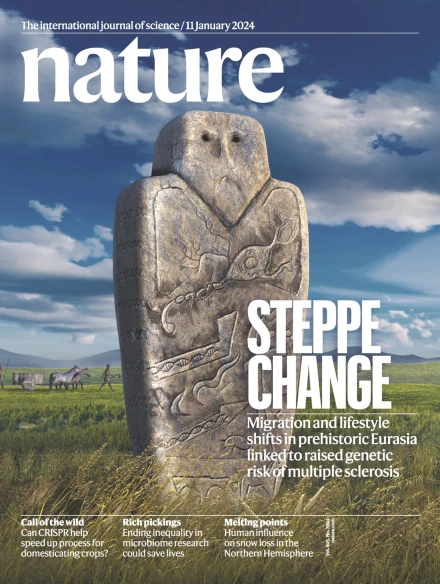High prevalence of sclerosis in Northern Europe can be traced back to the Bronze Age
Lise Torp Jensen from the Department of Clinical Medicine was an instrumental part of a research project featured on the cover of the journal Nature on Tuesday. Headed by the eminent DNA researcher Eske Willerslev, the team released four groundbreaking studies about our Danish ancestors' history, diseases, and genetic makeup.

In a groundbreaking study, an international team of researchers, led by the prominent DNA researcher Eske Willerslev, has attempted to shed light on the possible connection between our distant ancestors and the enigmatic disease multiple sclerosis (MS).
The study is part of a large project where Willerslev's team has explored the history of the Danes, European migrations, and the origins of several diseases. The project culminated on Tuesday with the publication of four articles in the journal Nature and coverage in several major Danish media.
Ph.D. and Senior Researcher Lise Torp Jensen from the Institute of Clinical Medicine has been one of the main forces in one of the sub-studies, with a special focus on MS.
By analyzing DNA from thousands of ancient skeletons, the researchers have traced MS-related gene variants back to a steppe people, the Yamnaya, who migrated from what is now Russia into Northern Europe about 5000 years ago.
"We have found a clear connection between Yamnaya ancestry and an increased risk of MS. We could see that the frequency of MS-related gene variants significantly increased from 5000 to 2000 years ago, indicating positive selection. This suggests that these genes gave their carriers an advantage in their time," explains Lise Torp Jensen, who is one of the lead authors of the study.

Significant Increase in the Number of Sclerosis Patients
MS is an autoimmune disease where the body's own immune system attacks nerve cells in the brain and spinal cord. The prevalence of MS has increased significantly over the past 50 years. Today, about 18,000 people live with MS in Denmark, of whom 2/3 are women.
The disease is incurable, and it is not precisely known why people develop MS. However, previous research has shown that the disease is due to an unfortunate interplay between risk genes and environmental factors.
To better understand this interplay, and thereby gain knowledge about the underlying causes, the researchers set out to investigate when, from where, and why the genetic risk for a "modern" disease like MS has emerged.
According to Lise Torp Jensen, the genes that today increase the risk of MS gave an advantage and likely provided protection against various viruses and bacteria in the Bronze Age.
Advantage Turned to Disadvantage
The Yamnaya people were a nomadic tribe that lived around 3300-2600 BC in the steppes of what are now Russia, Ukraine, and Kazakhstan. They are thought to be among the most important ancestors of the Indo-Europeans and have contributed significantly to the genetic makeup of modern Europeans.
The researchers believe that as the Yamnaya people had a close relationship with their livestock and introduced new lifestyle changes – including a diet rich in animal products – they were exposed to new types of pathogens.
"This finding contributes to our understanding of how changes in diet, lifestyle, and population density affect our genetics and thus our health. The gene variants that were once an advantage for our ancestors can now be a disadvantage in our modern society, where lifestyle, diet, and hygiene have radically changed. Our immune system is thus out of sync with our modern environment and lifestyle, and this can lead to overactivity or misregulation of the immune system, which can lead to MS," explains Lise Torp Jensen.
Important Step on a Long Road
Previous research has shown that genetic factors only explain 30 percent of the total risk for the disease. About 20 percent of Danes have the greatest genetic risk factor – an immune gene called HLA-DRB1*1501.
In addition, the researchers believe that especially infections, but also smoking, diet, and elevated BMI can be triggering factors for the – genetically speaking – most vulnerable individuals.
The discovery of the genetic roots of MS does not immediately lead to a cure, but it gives researchers a deeper understanding that the treatment of the disease is up against deeply rooted evolutionary forces. Insight into the disease's origin can be the first step on the path to more effective treatment.
"After more than 20 years of research, we are still not very far in understanding how genetics, environment, and lifestyle interact and cause MS, but even though we are far from a cure, this research gives us an important piece of the puzzle. Every time we identify a new factor that contributes to the development of the disease, we gain a deeper understanding of how MS works, which in the long run can pave the way for new treatment methods," says Lise Torp Jensen.
More information - behind the result
Study Type: Genetic Epidemiological Study.
Funding: Lundbeck Foundation, Denmark; Wellcome Trust, United Kingdom; European Research Council, EU; National Institutes of Health, USA; Danish National Research Foundation, Denmark; Novo Nordisk Foundation, Denmark; The Wellcome Trust Centre for Human Genetics, United Kingdom.
Collaborators: MRC Integrative Epidemiology Unit, Population Health Sciences, University of Bristol, Bristol, UK; Lundbeck Foundation GeoGenetics Centre, Globe Institute, University of Copenhagen, Copenhagen, Denmark; Pathogen Genomics and Evolution Group, Department of Veterinary Medicine, University of Cambridge, Cambridge, UK; Departments of Integrative Biology and Statistics, University of California, Berkeley, Berkeley, CA, USA; Eco-anthropologie (EA), Muséum National d'Histoire Naturelle, CNRS, Université de Paris, Musée de l'Homme, Paris, France; Laboratory of Biological Anthropology, Department of Forensic Medicine, University of Copenhagen, Copenhagen, Denmark; Ålborg Historical Museum, Nordjyske Museer, Vestbjerg, Denmark; Museum Østdanmark–Djursland og Randers, Randers, Denmark; Museum Vestsjælland, Holbæk, Denmark; Trace and Environmental DNA (TrEnD) Laboratory, School of Molecular and Life Sciences, Curtin University, Perth, Western Australia, Australia.
Potential Conflict of Interest: None.
Link to publication: https://www.nature.com/articles/s41586-023-06618-z#Abs1
Contact
PhD and Senior Researcher Lise Torp Jensen
Department of Clinical Medicine, Aarhus University
liset@clin.au.dk
Phone: +45 78455019